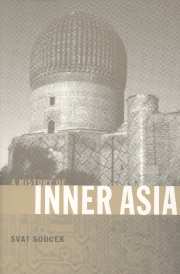Book contents
- Frontmatter
- Contents
- List of maps
- Preface
- Introduction
- 1 The beginnings
- 2 The Kök Turks, the Chinese expansion, and the Arab conquest
- 3 The Samanids
- 4 The Uighur kingdom of Qocho
- 5 The Qarakhanids
- 6 Seljukids and Ghaznavids
- 7 The conquering Mongols
- 8 The Chaghatayids
- 9 Timur and the Timurids
- 10 The last Timurids and the first Uzbeks
- 11 The Shaybanids
- 12 The rise of Russia, the fall of the Golden Horde, and the resilient Chaghatayids
- 13 The Buddhist Mongols
- 14 Bukhara, Khiva, and Khoqand in the seventeenth to nineteenth centuries
- 15 The Russian conquest and rule of Central Asia
- 16 From Governorates-General to Union Republics
- 17 Soviet Central Asia
- 18 Central Asia becomes independent
- 19 Sinkiang as part of China
- 20 Independent Central Asian Republics
- 21 The Republic of Mongolia
- Summary and conclusion
- Appendix 1 Dynastic tables
- Appendix 2 Country data
- Select bibliography
- Index
13 - The Buddhist Mongols
Published online by Cambridge University Press: 05 June 2012
- Frontmatter
- Contents
- List of maps
- Preface
- Introduction
- 1 The beginnings
- 2 The Kök Turks, the Chinese expansion, and the Arab conquest
- 3 The Samanids
- 4 The Uighur kingdom of Qocho
- 5 The Qarakhanids
- 6 Seljukids and Ghaznavids
- 7 The conquering Mongols
- 8 The Chaghatayids
- 9 Timur and the Timurids
- 10 The last Timurids and the first Uzbeks
- 11 The Shaybanids
- 12 The rise of Russia, the fall of the Golden Horde, and the resilient Chaghatayids
- 13 The Buddhist Mongols
- 14 Bukhara, Khiva, and Khoqand in the seventeenth to nineteenth centuries
- 15 The Russian conquest and rule of Central Asia
- 16 From Governorates-General to Union Republics
- 17 Soviet Central Asia
- 18 Central Asia becomes independent
- 19 Sinkiang as part of China
- 20 Independent Central Asian Republics
- 21 The Republic of Mongolia
- Summary and conclusion
- Appendix 1 Dynastic tables
- Appendix 2 Country data
- Select bibliography
- Index
Summary
Toghon Temür, the last Yüan emperor of China and a Genghisid of the Toluy-Qubilay line, fled in 1368 to Mongolia after the dynasty's defeat and replacement by the national Ming Dynasty. From then on, his descendants and those of other Genghisid lineages would claim the right to rule the Mongols, but without achieving the re-establishment of even a unified Mongolia, to say nothing of a resurrection of the Genghisid empire. The challenge of reconquering the northern and western portions of Mongolia itself, with the historic region of Qaraqorum, from their linguistic cousins the Oirats proved an arduous and protracted task. The able and energetic Dayan Khan (enthroned in 1470, ruled from 1481) failed to do so despite the campaigns he waged from 1492 on, and success was granted only to his equally remarkable grandson Altan Khan (1543–83) and the latter's great-nephew Khutukhtai Sechen Khungtaiji, chief of the Ordos tribes (1540–86). Their victory over the Oirats in 1552 was to benefit especially the Khalkha component of the Eastern Mongols, who occupied these central and northwestern segments of the country that eventually became the core of modern Mongolia. For the time being, however, the center of political power among Eastern Mongols was in territories corresponding to what is now Inner Mongolia, more specifically areas inhabited by the tribes of Tüet and Ordos.
- Type
- Chapter
- Information
- A History of Inner Asia , pp. 167 - 176Publisher: Cambridge University PressPrint publication year: 2000



